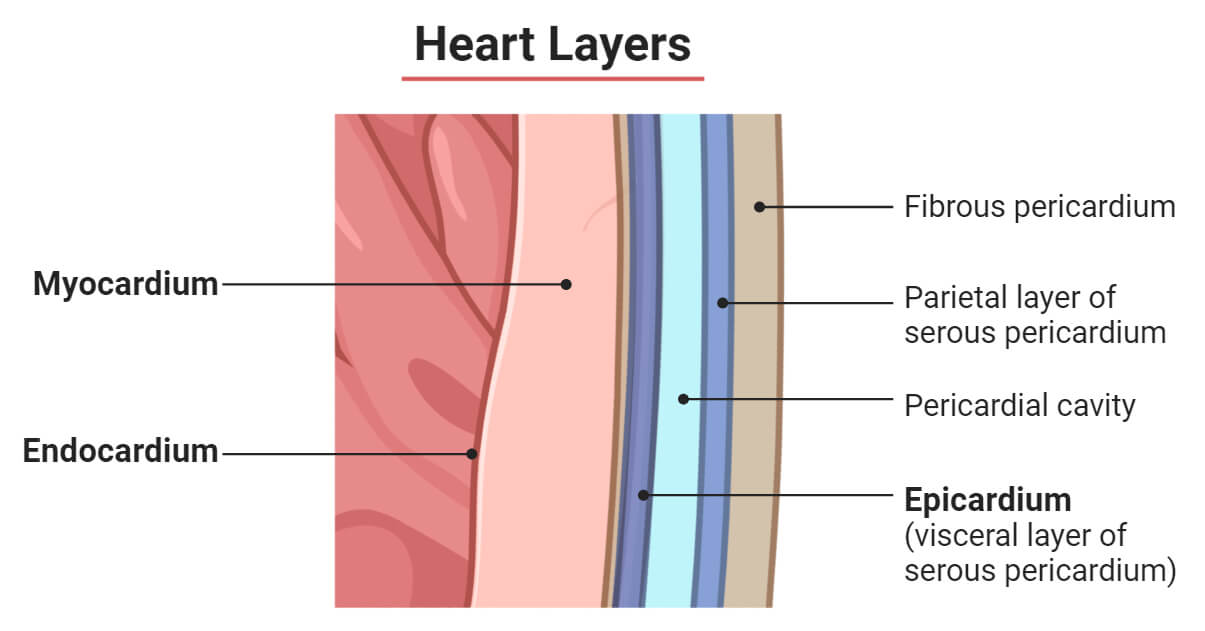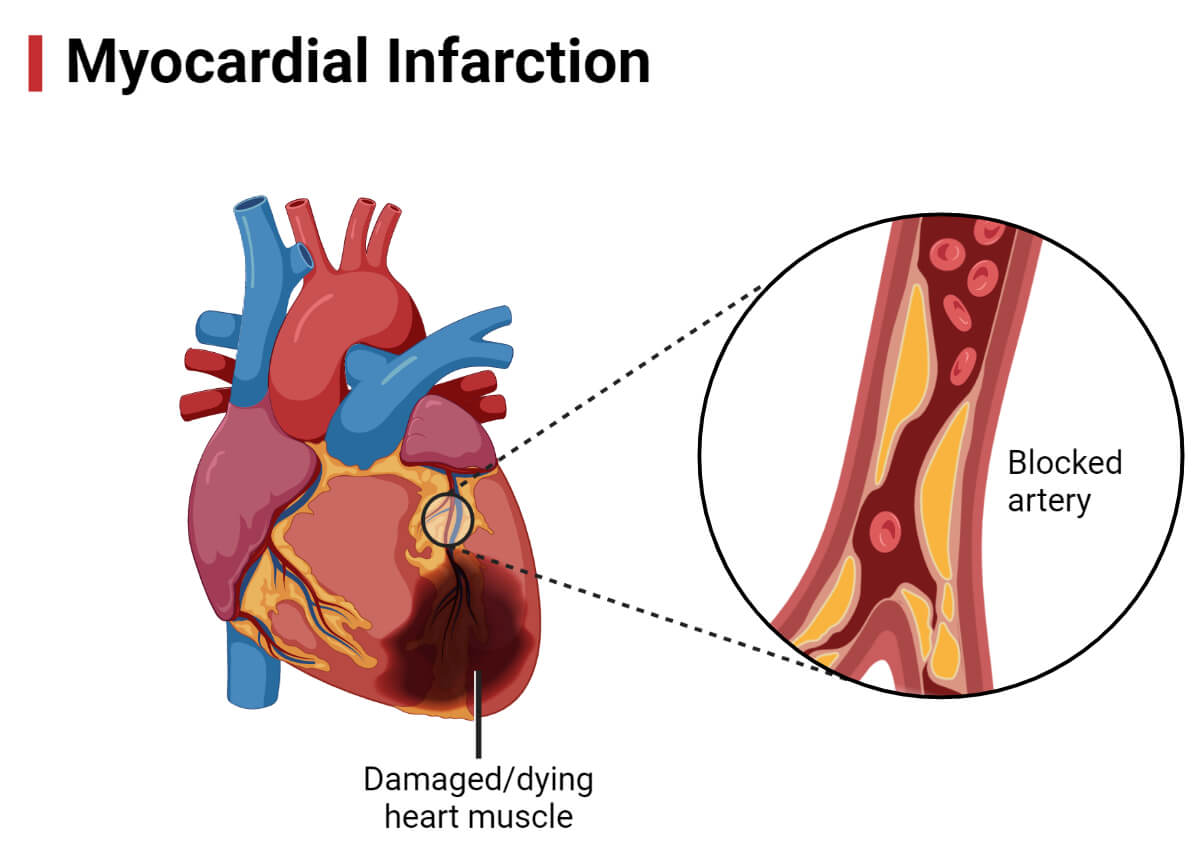There are three layers of the heart. They are:
- Epicardium (Outermost Layer of Heart)
- Myocardium (Middle Layer of Heart)
- Endocardium (Innermost Layer of Heart)

Interesting Science Videos
1. Epicardium (Outermost Layer of Heart)
- The epicardium is the outermost layer of the heart wall made up of mesothelium, fats, and connective tissues. It forms the inner serous layer of the pericardium; hence, it is also known as the visceral serous pericardium.
- Epicardium encloses the heart as well as the root of major blood vessels emerging from the heart like the aorta and the two vena cava. It is also supplied by several coronary blood vessels, nerve fibers, and lymphatic vessels.
- Location: Anatomically, it is located just beneath the parietal serous pericardium layer of the pericardium and is in direct contact with the myocardium.
Epicardium Structure
- Histologically, it contains an outer layer of epithelium cells called the mesothelium below which is the subserosal layer made of connective tissues and a layer of fatty tissues. It can be divided into two sub-layers based on their composition, viz. serous membrane and subepicardial layer.
- The serous membrane/layer is the outer layer made of mesothelial tissue. Whereas, the subepicardial layer is beneath the serous layer and is made of loose connective tissues and adipose tissue.
- The subepicardial layer houses blood vessels, lymphatic vessels, and sympathetic as well as parasympathetic nerves.
Functions of Epicardium
- Its major function is to provide mechanical protection to the heart.
- The serous layer secrets thin fluid called the pericardial fluid that lubricates the heart and reduces friction during the pumping of the heart.
- Being supplied with blood and lymph vessels, it also helps to distribute nutrients and oxygen to the heart wall and collect and transport the wastes.
Epicardium-associated Diseases
- Epicardium itself alone is not generally affected by diseases; however, diseases of pericardium or endocardium may extend up to epicardium and affect it.
2. Myocardium (Middle Layer of Heart)
- Myocardium is the middle thickest muscular layer made up of cardiomyocytes. It is responsible for the contraction and relaxation actions of the heart. The SA (sinoatrial) and the AV (atrioventricular) nodes of the heart conduction system are mostly located in this layer.
- Location: It is the middle layer located between the epicardium and the endocardium.
Myocardium Structure
- Histologically, the myocardium is primarily composed of cardiac muscle cells (cardiomyocytes) (arranged in a group called myofibers) and a few fibroblast cells. The cardiomyocytes are connected with each other through the intercalated discs.
- Anatomically, it is the thickest layer of the heart wall. It is thicker in the ventricular wall than in the auricular wall – particularly in the left ventricle, which is the thickest layer. The left ventricular myocardium is further subdivided into three sub-layers, namely subepicardial, mid-myocardial, and subendocardial layers.
- It is well supplied with coronary arteries and coronary veins and cardiac lymphatic vessels. It is also innervated with a cardiac conduction system composed of specialized cardiomyocytes.
Functions of Myocardium
- Its major function is to contract and generate the force for the contraction of the heart wall.
- The myocardium houses the Pacemaker cells and specialized cardiomyocytes that generate and conduct the cardiac electric impulses.
Myocardium-associated Diseases
The myocardium is affected by a range of diseases collectively called myocardial diseases. Some of the common myocardial diseases are listed below.
| Disease | Introduction |
| Myocardial infarction | Blockage of the blood flow in the myocardium leads to a heart attack. |
| Myocarditis | Inflammation of the myocardium. |
| Myocardial fibrosis | A condition of the formation of excessive fibrous tissues in the myocardium. |
| Myocardial ischemia | Reduction in the oxygen supply to the myocardium due to restriction in blood flow. |

3. Endocardium (Innermost Layer of Heart)
- The endocardium is the innermost layer of the heart wall lining the internal chambers of the heart and the heart valves. It provides a smooth surface for efficient blood flow inside the heart chambers. It also houses capillaries to supply blood to the heart muscles, nerve fibers, and heart conduction cells.
- Location: It is found along the walls of the atria and the ventricles and as the outer covering of the four heart valves.
Endocardium Structure
The endocardium is primarily composed of smooth endothelial and connective tissues and a smaller fraction of smooth muscle cells. Anatomically, the endocardium can be divided into three sub-layers, viz. the endothelial layer, the subendothelial layer, and the subendocardial layer.
- Endothelial Layer
It is the innermost layer composed of specialized flat and smooth endothelial cells. This layer makes the surface smooth and allows easy blood flow without any friction, clotting, or sticking.
- Sub-endothelial Layer (fibro-elastic tissue layer)
It is the middle layer composed of connective tissue containing collagen, elastic fibers, and a few smooth muscle cells. Due to its composition, it is also called the ‘fibro-elastic tissue layer’. This layer provides structural support to the endocardium.
- Sub-endocardial Layer
It is the innermost layer primarily composed of connective tissues. This layer is enriched with capillaries, nerves, and cardiac conductive cells (Purkinje fiber).
Functions of Endocardium
- It lines the chambers and valves of the heart and provides a non-adhesive surface for efficient blood flow without adherence of platelets and blood clotting.
- It acts as a blood-heart barrier.
- It also allows smooth opening and closing of the heart valves.
- It houses the Purkinje fibers and hence supports the heart’s conductive system.
Endocardium associated medical conditions
The endocardium is affected by several medical conditions called endocardial diseases. Some of the common endocardial diseases are listed below.
| Disease | Introduction |
| Infective Endocarditis | Inflammation of the endocardium due to infection. |
| Endocardial Fibroelastosis | A condition where the elastic and fibrous layer of the endocardium is thickened. |
| Nonbacterial Thrombotic Endocarditis (NBTE) | A condition characterized by the formation of a blood clot on the endocardium leading to its inflammation. |
| Libman-Sacks Endocarditis | A condition characterized by the formation of small sterile vegetations, primarily on the valves. |
| Carcinoid Heart Disease (CHD) | A condition characterized by fibrosis and thickening of mostly the endocardium of the right side of the heart in patients with carcinoid tumors. |
References
- Epicardium: What Is It, Functions, and More | Osmosis
- The 3 Layers of the Heart Wall (thoughtco.com)
- Epicardium | anatomy | Britannica
- Pericardium. (2023, May 21). In Wikipedia. https://en.wikipedia.org/wiki/Pericardium
- Epicardium | Radiology Reference Article | Radiopaedia.org
- Epicardium – an overview | ScienceDirect Topics
- Epicardium: Definition, Function, Pericardial Membranes and Pericardial Disorders – Scope Heal
- Human cardiovascular system – Cardiac Muscle Cells, Actin & Myosin Filaments, Intercalated Discs | Britannica
- Epicardium – Definition & Function – Human Anatomy | Kenhub – YouTube
- Heart histology: Cells and layers | Kenhub
- Epicardium – Earth’s Lab (earthslab.com)
- Ross & Wilson Anatomy & Physiology in Health and Illness. 13th ed. Churchill Livingstone Elsevier. ISBN 978-0-7020-7276-5
- The 3 Layers of the Heart Wall (thoughtco.com)
- Myocardium of the Heart (thoughtco.com)
- Myocardium Definition and Examples – Biology Online Dictionary
- Myocardium | Radiology Reference Article | Radiopaedia.org
- Myocardium | anatomy | Britannica
- Myocardium Function, Location & Parts | What is the Myocardium? – Video & Lesson Transcript | Study.com
- https://www.mayoclinic.org/diseases-conditions/myocardial-ischemia/diagnosis-treatment/drc-20375422
- Crossman DC. The pathophysiology of myocardial ischaemia. Heart. 2004 May;90(5):576-80. doi: 10.1136/hrt.2003.029017. PMID: 15084567; PMCID: PMC1768241.
- https://www.hopkinsmedicine.org/health/conditions-and-diseases/cardiomyopathy
- Bailey, Regina. “Myocardium of the Heart.” ThoughtCo, Aug. 27, 2020, thoughtco.com/myocardium-anatomy-373234.
- Dye, B., & Lincoln, J. (2020). The Endocardium and Heart Valves. Cold Spring Harbor Perspectives in Biology, 12(12). https://doi.org/10.1101/cshperspect.a036723
- https://www.sciencedirect.com/topics/pharmacology-toxicology-and-pharmaceutical-science/endocardial-disease
- https://www.sciencedirect.com/topics/medicine-and-dentistry/endocardial-fibroelastosis
- Sana MK, Mahajan K. Endocardial Fibroelastosis. [Updated 2023 Jan 24]. In: StatPearls [Internet]. Treasure Island (FL): StatPearls Publishing; 2023 Jan-. Available from: https://www.ncbi.nlm.nih.gov/books/NBK559128/
- Ibrahim AM, Siddique MS. Libman Sacks Endocarditis. [Updated 2022 Sep 5]. In: StatPearls [Internet]. Treasure Island (FL): StatPearls Publishing; 2023 Jan-. Available from: https://www.ncbi.nlm.nih.gov/books/NBK532864/
- Ram, P., Penalver, J. L., U. Lo, K. B., Rangaswami, J., & Pressman, G. S. (2019). Carcinoid Heart Disease: Review of Current Knowledge. Texas Heart Institute Journal, 46(1), 21-27. https://doi.org/10.14503/THIJ-17-6562
- Endocardium: Function, Location, and Importance (verywellhealth.com)
- Endocardium. (2023, March 5). In Wikipedia. https://en.wikipedia.org/wiki/Endocardium
- Layers of the heart: Epicardium, myocardium, endocardium | Kenhub
- 17.1C: Layers of the Heart Walls – Medicine LibreTexts
- The 3 Layers of the Heart Wall (thoughtco.com)
- Heart histology: Cells and layers | Kenhub
- Endocardium Overview, Parts & Function | What is the Endocardium? – Video & Lesson Transcript | Study.com
- The Anatomy of the Heart, Its Structures, and Functions (thoughtco.com)
- The Heart Wall – TeachMeAnatomy
- Endocardium – an overview | ScienceDirect Topics
